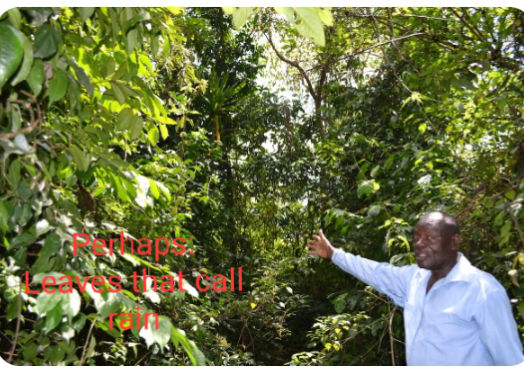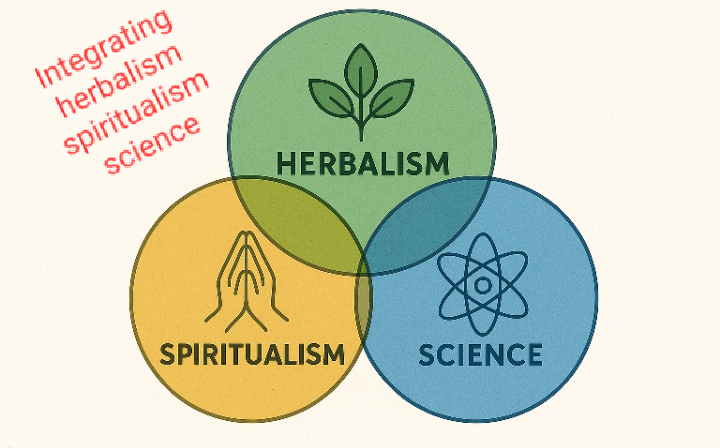
Leaves that call rain: Uniting Science and Tradition for Africa’s Green Breakthrough
Rain sustains all living things.
In science, it begins when water vapor condenses into clouds and returns to the earth as droplets.
In many African communities, however, rain is seen as a dialogue between the sky and the earth — a sacred conversation often guided by rain priests and the power of leaves.
Science explains how rain happens.
Tradition explains why it happens.
Together, they reveal a deep harmony between people and nature, that is the notion of leaves that call rain.
To understand how leaves that call rain may actually work, we start with simple science. When sunlight warms oceans, rivers, and plants, water evaporates and rises as vapor. At the same time, leaves release moisture through transpiration — a natural process where plants breathe out tiny water particles into the air.
When billions of leaves do this together, the atmosphere fills with moisture.
As air rises and cools, vapor condenses around dust or pollen to form clouds.
When droplets become heavy, they fall as rain.
This is how forests act as rainmakers of nature.
So even in science, we see the silent influence of leaves on rain.
They do not “command” clouds, but they create the very conditions that make rain possible.
Long before satellites and weather stations, African communities studied these patterns.
The Annang of Akwa Ibom, Yoruba of southwestern Nigeria, the Igbo of the southeast, the Edo, Nupe, Shona of Zimbabwe, and the Zulu of South Africa all developed traditional systems of rainmaking.
In these rituals, elders or rain priests select sacred leaves from trees believed to “speak to the sky.” that is leaves that call rain.
They combine them with natural materials and chant prayers.
The goal is to invite rain or calm storms.
While modern science does not yet prove these effects, the timing often matches periods of high humidity, showing that traditional rainmakers understood nature’s rhythm.
Oral traditions mention that certain materials are mixed with leaves that call rain.
Some examples include:
Each item has symbolic value but also natural relevance. Charcoal, for instance, absorbs heat; oil reduces surface friction on water; ashes alter pH. These physical effects mirror the symbolic purpose.
Could this mean that African traditions were early experiments in eco-meteorology?
Modern research confirms what tradition observed. Leaves release moisture and organic compounds that can serve as condensation nuclei — the particles around which clouds form. When leaves burn, decompose, or transpire, they send micro-elements into the air, helping moisture gather.
Thus, leaves that call rain are not just folklore; they are part of an ancient environmental process.
Forests literally create their own weather systems.
When we destroy trees, we silence the natural voices that once called the rain.
To move forward, we look to Africa’s traditional ecological custodians — those who have studied nature through experience:
Their knowledge has guided communities for centuries. Combining their insight with modern research could create Africa’s first Leaf-Based Climate Innovation-leaves that call rain.
Studies from NASA and FAO confirm that vegetation increases rainfall by releasing moisture and cooling air. Deforestation, by contrast, reduces local rainfall and raises temperatures.
If such global findings meet the wisdom of Africa’s rain custodians, we could pioneer a new science — a blend of traditional weather intuition and modern ecology. Imagine CombiHs leading this movement, turning ancient practices (leaves that call rain) into verified natural climate solutions.
Africa’s next breakthrough might not emerge from machines or factories. It might grow from leaves, soil, and sky. Other nations found progress in air and metal; Africa can find hers in nature’s green heart.
CombiHs invites farmers, students, and researchers to join the Leaves That Call Rain Initiative. Help us document local beliefs, identify rain leaves, and test their real-world effects. Could your community hold the next discovery in climate innovation?
Imagine rain priests and scientists working together — measuring vapor, testing leaf oils, studying forest microclimates.
This cooperation could form the base of Africa’s first Eco-Rain Science.
By respecting both tradition and data, we could manage rainfall naturally, without chemicals or machines.
In this union of worlds, the power of nature becomes a partner for progress.
It proves that our ancestors’ wisdom still holds keys to modern sustainability.
Rainmaking is not merely ritual or myth; it is heritage. Science may not yet translate all that tradition knows, but it can listen.
Together, they can reveal how the earth breathes and how the sky responds.
If Africa blends its traditional knowledge with scientific exploration, our forests could once again call the rain—and our future could thrive in balance.
Share your insight. Every leaf story counts.
Together, we can uncover Africa’s next great discovery—our breakthrough in leaves.
Contribute your community knowledge, photos, or experiences with rainmaking leaves.
Use hashtags #LeavesThatCallRain and #CombiHsGreenBreakthrough on Facebook, Instagram, or Medium.
Invite others to share — because Africa’s future innovation may grow not from machines, but from the living power of leaves.
Explore more

Explore traditional herbal wisdom and daily plant practices that promote balance, health, and lasting vitality for true herbal longevity.

True wellness unites nature, faith, and knowledge. This post explores how herbalism, spiritualism, and science can integrate to form a balanced system of holistic health care — where body, mind, and spirit heal together.
We deliver core herbal procedure cures for our users for better and more efficient health value.
Lets discus your health
Connect with us